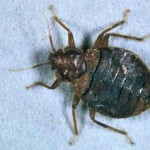
Bed bugs are extremely prolific insects, as they are able to maintain an active existence in a variety of settings. There are not many locations or settings that are immune to a bed bug infestation. These pests are very resilient to many types of pesticides, and they are also able to reproduce rapidly and with very little effort. Females can lay eggs every three to four days, making them one of the most difficult pests to control.
Contrary to popular belief, bed bugs are not only found in homes and motels. Likewise, they do not only live in dirty areas or in areas frequented by those with lower income levels. Bed bugs can exist in the most luxurious hotels and resorts, as well as in movie theaters, schools, cruise ships, libraries, retail establishments, hospitals, office buildings, on public transportation, and anywhere that there is a presence which can offer feeding opportunities. To make matters worse, bed bugs find it easy to travel from one area to another, and they are often discovered in suitcases, handbags, and shoes.
Although bed bugs do not have wings, they manage to find a way to spread at a disturbingly rapid pace. Before addressing and comparing the most effective treatment for bed bugs, it is a good idea to learn a little more about bed bugs.
Where Are Bed Bugs Found?![]()

Bed bugs can be found on almost every continent in the world. They can be found in any type of building or establishment, but they are most frequently found in residential areas, such as single family homes, apartment complexes, condominiums, military barracks, motels, hotels, and refugee camps. This is because bed bugs prefer to build their nests near areas where human beings are prone to sleep, according the the Centers for Disease Control and Prevention.
As bed bugs find it easy to travel from one area to another, international travel has enabled these pests to make a comeback in areas where they were previously believed to be eradicated, such as in the United States.
Bed Bug History
Most people have heard the old saying, “Good night, sleep tight, don’t let the bed bugs bite.” However, most people don’t understand the significance or even how long bed bugs have been a nuisance to people. According to the History Channel, fossilized bed bugs that are more than 3,000 years old have been found in Egypt. These blood-sucking creatures have been immortalized in plays by an ancient Greek writer named Aristophanes around 400 B.C., the Jewish Talmud, and several other ancient literary sources.
Although mainly considered to be a nuisance, such as they are today, at certain points in time they were actually prized for alleged medicinal purposes. According to Pliny, who was a Roman philosopher, bed bugs could cure many medical conditions, including ear infections and snake bites.
United States Eradication of Bed Bugs
For almost 30 years, the United States enjoyed a time with extremely low to nonexistent populations of bed bugs. This began with the development of DDT, which nearly eradicated bed bug populations all across the country. DDT, an insecticide, was introduced to combat many insect-borne diseases that were running rampant throughout some populations. DDT was originally developed to kill carriers of other diseases, such as malaria and typhoid, in the 1940s. However, as a result of its development, bed bugs were all but wiped out by the 1950s. Shortly thereafter, DDT and other chemicals that were effective in the eradication of bed bugs soon became outlawed for use by the Environmental Protection Agency. This is because DDT, chlordane, diazinon, and others are also extremely hazardous to other life forms, including human beings. With the increase in international travel and the elimination of the pesticides that were most effective in killing bed bugs, these nuisance insects have made a huge comeback in recent years, especially in major cities within the United States.
How to Identify Bed Bug Bites![]()
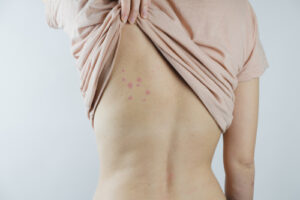
Before determining the most effective bed bug treatment, it is important to identify whether or not you have a real problem. Bed bugs are the most active at night, which explains why they bother us while we sleep. It is rare to feel a bed bug as they bite you, because they inject a small amount of anesthetic before they bite. Sometimes it can take a few days to realize that you have been bitten. Bed bug bites are small, red bites that are often found in clusters, and very often in a line. Bed bug bites are usually quite itchy. They can be identified by the dark center of each bite.
Bed bugs usually bite exposed areas of skin, such as the arms, hands, neck and face. Bites can also often be found along a line of clothing. Bed bugs don’t bite every night, which can sometimes make it more difficult to identify a bed bug problem, and therefore find the best solution. These bites can take anywhere from a few days to a few weeks to disappear, depending on the person.
Health Risks of Bed Bug Infestations
According to the CDC, bed bugs do not transmit communicable diseases. However, this does not make bed bugs harmless. People can be mildly to severely allergic to the bite of these insects, and may require immediate medical treatment. The bites of bed bugs also lead to infection risk. Bed bug infestations might lead to mental health issues, causing extreme stress, anxiety, and insomnia for those who are affected. Once someone has experienced the inconvenience and stress of a bed bug situation, they are forever affected. They will most likely experience ongoing fear and anxiety when it comes to bed bugs and the fear of recurrence.
How to Identify a Bed Bug Infestation
It is important to accurately diagnose the problem before determining the most effective bed bug treatment. Unfortunately, it is not always easy to identify a bed bug problem. It is said that it is difficult to pinpoint a bedbug problem as a result of bites alone, as there are plenty of other bugs that can leave similar bites. There are some common signs to look for, however, that can point to a bed bug infestation. One of the most common is blood stains on sheets or pillowcases. The blood is left behind after bed bugs eat. The blood sometimes appears red, but it is more likely to appear brownish in color. Another telltale sign that you have a bedbug problem is dark spots on your mattress. These are left behind when bed bugs are crushed. Occasionally, a bad smell will accompany a bed bug problem. 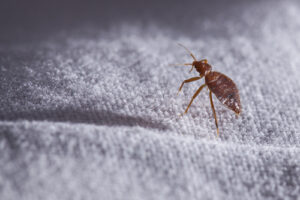
Bed bugs can be hard to find during the day, because they like to hide in dark places. These may include seams of mattresses or furniture, junctions where walls and ceilings meet, or in cracks in the bed frame and headboard.
Top 3 Most Effective Bed Bug Treatments
Bed bug treatments often depend on a variety of factors. These include the severity of the infestation, costs of treatment, and choice of the occupant in the area where the infestation of bed bugs occurs. However, there are basically three effective treatment options for the eradication of bed bugs. These treatments may overlap or need to be combined for the most successful treatment outcomes. Treatment options include:
- Home use of chemical pesticides
- Nonchemical home treatment options
- Professional treatment
Home use of chemical pesticides![]()

This method involves treating bed bug infestations directly with the use of chemical or natural pesticides. Three fairly safe and natural products to eradicate bed bugs are Kleen Green, Bug Patrol, and Best Yet. The downside to this choice of bed bug treatment is that these products only reduce current bed bug populations for short term protection. Because of this, they almost always need to be combined with preventive measures to prevent a return infestation. This method of home bed bug treatment should only be considered if it is clear that the situation is not extreme, and there are only a few bed bugs to deal with.
Severe infestations of bed bugs should be treated professionally at first. Then at times, they can be kept from returning with at-home efforts.
Non-chemical home treatment
These options are also effective in eradicating bed bug populations. However, these treatments require some time and effort. Bed bugs can be found nearly anywhere, but prefer to reside near sleeping areas. The mattress is a good place to start a search, but bed bugs also hide in many other areas. This could include in furniture, behind picture and outlet covers, and in areas of clutter. In extreme infestation situations, they are on the ceiling and walls, and even in drawers.
Bed bugs can be killed by the use of hot or freezing temperatures. Although a good idea, it is difficult to figure out a way to actually eradicate bed bugs using this home method. Bed bugs and eggs can be killed when items are washed in hot water or placed in a hot dryer for at least 20 minutes.
Vacuuming can remove bed bugs as well, however, it may be very difficult to get rid of an entire bed bug population using this method. Placing items in a freezing environment is also quite effective, but items must be in below freezing temperatures for several days. Again, it is difficult to use the freezing method to treat enough of the bed bugs for the treatment to be effective. This treatment is only effective in situations when the infestation is minor, as it is obviously more difficult to treat with temperature control when there are more bugs to kill.
Professional treatment
Pest control companies may use chemical, non-chemical, or a variety of other methods to reduce bed bug populations. Professional treatment may even include the use of highly trained dogs to help locate the pesky critters. Exterminators have many options when assessing a bed bug situation. After determining the severity of the infestation and consulting with the homeowners, business owners, or tenants, they will determine which option is most ideal for the successful treatment of the bed bugs.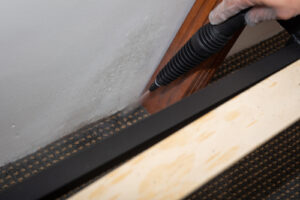
When using less drastic methods, the complete eradication of bed bugs sometimes takes multiple visits. This is the case even when treated professionally. These methods may include chemical treatments, such as insecticides.
One of the most effective professional treatment methods is heat. If you want to be sure that the bed bugs are gone once and for all, this is proven to be the safest route to take. When done correctly, only one professional heat treatment should be enough to clear out the problem. In the case of heat treatment, professionals would raise the temperature of an entire living space or affected area to such a degree that bed bugs would not be able to survive. For example, bed bugs die within 90 minutes when exposed to temperatures of 118 degrees fahrenheit. They die immediately at 122 degrees fahrenheit. This works to kill all bed bug eggs as well.
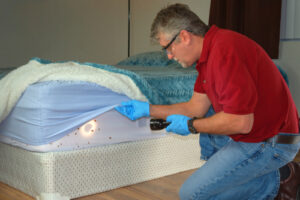 In extreme situations, professional treatment is most likely the only effective treatment for an affected home or business. When living in a shared housing situation such as an apartment or condo, it is best to pursue professional treatment. The reason for this is that there are more potential locations for the bed bugs to spread to. The down side to this treatment is that professional exterminators are very expensive. Treating bed bugs this way could end up costing thousands of dollars. Professional exterminators will give recommendations that must be completed by residents in order to prevent continued or further infestations. Even though the price tag can be high, professional treatment is more often than not the most effective bed bug treatment.
In extreme situations, professional treatment is most likely the only effective treatment for an affected home or business. When living in a shared housing situation such as an apartment or condo, it is best to pursue professional treatment. The reason for this is that there are more potential locations for the bed bugs to spread to. The down side to this treatment is that professional exterminators are very expensive. Treating bed bugs this way could end up costing thousands of dollars. Professional exterminators will give recommendations that must be completed by residents in order to prevent continued or further infestations. Even though the price tag can be high, professional treatment is more often than not the most effective bed bug treatment.
Help Reduce Bed Bug Infestations
With a little care and effort, people can reduce the risk of a bed bug infestation in their homes. Use plastic or vinyl mattress and pillow covers on the beds to prevent bed bugs from living there. Check frequently for signs of bed bug infestation and bed bug eggs, especially in or around sleeping areas. When traveling, keep suitcases and luggage off the floor. Preventing bed bugs goes a long way to reduce the risk of an infestation, which can be extremely difficult to treat.
Related to public health issues:
MPH Staff, Updated September 2022